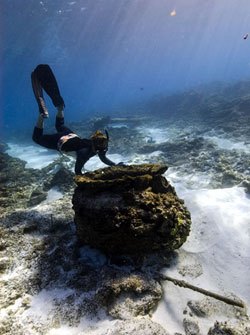
Historic Feature: Try pots

Hoku Johnson peers inside of a try pot at the British whaling ship Pearl. Photo Credit: Tane Casserly
Whaling vessels from the 19th century used large iron pots, called try pots, to liquify whale blubber. Once boiled down, the liquid oil would be stored in wooden casks beneath deck. The try pots were mounted in a structure called the try works on the top deck and finding these artifacts on a wreck site are evidence that the vessel was a whaler. The British whaling ship Pearl, grounded on an uncharted reef in the NWHI later named Pearl and Hermes Reef, had a try works on deck. Discovered in 2004 by NOAA divers, the Pearl wreck site has four of these remaining try pots, still relatively intact, resting on the bottom. There are also try pots at other shipwreck sites in the Monument - the Hermes, Gledstanes (at Kure Atoll) and the Two Brothers (at French Frigate Shoals). Maritime artifacts are protected by Federal and State regulations, and help to teach us about our rich maritime heritage.
Click Here for more information.
